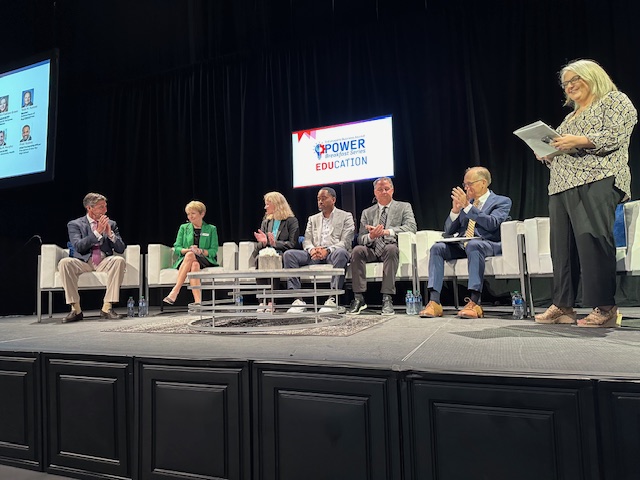Subscriber Benefit
As a subscriber you can listen to articles at work, in the car, or while you work out. Subscribe NowAs the state continues to retool its workforce development pathways for students, proponents of student experiences in the workplace are asking businesses to continue working with education and state partners to offer such opportunities—and then stick with it when it’s difficult.
At IBJ’s Education Power Breakfast event on Wednesday morning, several leaders in the sector emphasized the impact that apprenticeships and other workforce development opportunities can have on students and the state’s workforce.
Indiana’s labor force participation rate was 62.5% in April, while the national rate was 62.7%. The Indiana rate is the percentage of Hoosiers 16 and older who are either working or actively looking for work. State leaders often tout the need to produce workers who have the skills that employers—especially high-wage employers—seek.
Noel Ginsburg, CEO of Colorado-based education not-for-profit CareerWise, said companies often dip their toe into apprenticeship and other workforce development programs and then pull out after difficulties. He encouraged business leaders to give these programs time and to realize that the desired results won’t happen immediately.
Positive effects take a significant amount of time to develop, Ginsberg said, and he encouraged business leaders to think of apprenticeships on a larger timeline for a return on investment.
Indiana University Health CEO Dennis Murphy said his company underwent a cultural shift when it allowed students under 18 to complete certain tasks. A significant piece of building a career-oriented system, he said, is allowing students to do “real work,” not just shadow employees.
“For a lot of employers, we’re afraid to give kids that much responsibility,” Murphy said. “They can step up, and they exceed your expectations every time you do that.’
Chris Lowery, commissioner of the Indiana Commission for Higher Education, told a story about a high school student who worked for the state, had two jobs and played sports—but she didn’t have a Social Security card.
Through a staff member’s commitment to supporting the student, he said, she excelled and has finished her first year at IU Indianapolis in the honors college.
“We can do this, … but there will be challenges. We just have to deal with being willing to accept those and deal with adversity for a long time,” Lowery said. “This is the right thing to do.”
Much of the conversation on Wednesday referenced a national program in Switzerland where the secondary education system is heavily focused on career and technical education and encourages high-quality apprenticeships.
A local delegation traveled to Switzerland last September to learn more about the country’s apprenticeship system. The Swiss system allows for high school students to seek either higher education courses or an apprenticeship, and then move in between the two with wraparound support after graduation, said Claire Fiddian-Green of the Indianapolis-based Richard M. Fairbanks Foundation.
“It’s really important that they created an equivalent high-value degree pathway—to actually see this as an essential diploma that has labor market value,” she said. “So they don’t have to go and get a college degree unless they choose to. And that was actually the thing I love about this whole system: If you change your mind or the labor market changes … they built pathways to make that possible.”
Leaders on the panel asked that employers of all kinds step forward to foster student apprenticeships.
Indiana House Speaker Todd Huston said the next step in the Statehouse is to commit to an education system that is more flexible and can facilitate these opportunities. He also mentioned that education funding, including for these type of programs, will be considered in the next legislative session.
“We need to try new things,” he said. “You can’t break broken.”
Please enable JavaScript to view this content.

